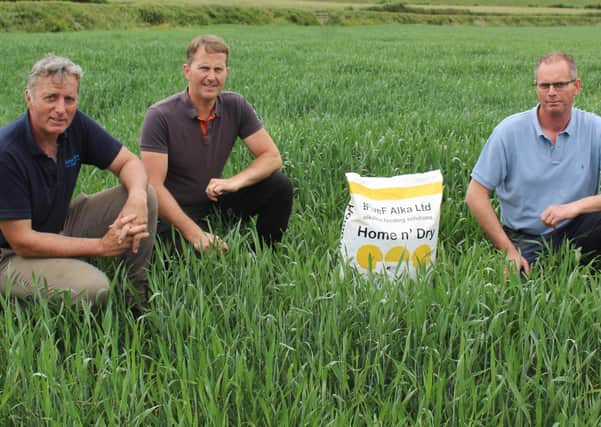Home n’ Dry® now available from Freeburn Farm Feeds


Over the past 30 years Home n’Dry® has been used to produce alkalised grain which, courtesy of the treatment process, contains significantly enhanced levels of protein.
Keith Freeburn of Freeburn Farm Feeds added: “Because of its enhanced pH, alkalised grain also acts to prevent acidosis when fed to dairy and beef cattle. Consequently, it represents a win:win scenario for farmers wishing to feed home produced grain to their own stock.”
Advertisement
Advertisement
Home n’ Dry® pellets are the foundation of Alkasystems technology – developed after extensive research and trials over 30 years ago, they are a unique, cost effective, high protein feed ingredient that enable farmers, nutritionists and feed manufacturers to maximise the potential of their crops, feeds and diets. Home n’ Dry is used to treat mature cereal grains and crops.
Home n’ Dry® pellets consist of approximately equal parts technical feed grade urea and full fat soya bean plus a percentage of other feed ingredients to stabilise the pellet. All soya in the pellets is Triple S® - Sustainably Sourced & Supplied.
Urea is the key nitrogen source for ammonia release from Home n’ Dry®. The engineering in the process of creating the pellets means that the resultant feed material contains virtually no measurable residue of urea. Easy to use in a one-step application; once in contact with moisture, Home n’Dry® pellets release ammonia into the subject crop or feed, destroying microbes, moulds and
mycotoxins - effectively sterilising the crop.
The resultant crops and feeds are alkaline, stable, increased in protein content and as the ammonia also reacts with lignin in plant cell walls, have enhanced digestibility. The high pH in the treated materials helps buffer the rumen against excess acidity and allows a whole new approach to feedstuffs and feeding techniques.
Advertisement
Advertisement
Keith Freeburn again: “Implementing a grain alkalisation system through the use of Home n’Dry® can help address the challenges in modern farming, by maintaining better feed intakes and overall animal condition, while consistently delivering higher output and increasing the use of own grown or locally sourced feeds and forages.”
He added:“Using Home n’9; Dry®couldn’t be easier. It works best with grains that have a moisture content of 20% or less.
“The product is added to grain as it is being rolled or crimped at a rate of 30kg per tonne of cereal. It can also be added to whole grain which is then rolled or crimped prior to feeding.
“The Home n’Dry® application rate can be quickly worked out by simply weighing the amount of grain contained in the first full shovel of rolled or crimped grain.”
Advertisement
Advertisement
The treated grains are then put in a dry, fit-for-purpose grain store and ensiled for 14 days.
“The ensiling process simply requires the grain pile to be covered with a standard silage cover and weighed down with tyres or other appropriate weights.”
After 14 days the grain pile is completely sterilised and stable. The alkalised cereal can then be included, as required, in a range of beef and dairy diets.
Analysis confirms that Home n’Dry® treated grain contains 4 - 5% more crude protein that conventionally dried or acid treated cereals. In beef trials carried out at Harper Adams University College, Alkagrain eliminated the need to include rape meal and soya, yet performance improved, compared with these other feeds. Liver scores were also improved in the animals fed the Home n’ Dry® treated grain. Other work has confirmed the improved rumen health, animal performance, feed efficiency and profitability of feeding Home n’Dry® treated diets to stock.
Advertisement
Advertisement
Farm experience here in Northern Ireland also confirms the benefits of treating home grown grain with Home n’Dry®.
Brothers David and Stephen Kane, from Loughgall in Co Armagh, produce wheat and barley as part of a cereals, potatoes and grass rotation on their farm. This year they are growing an equal mix of spring wheat and spring barley. They used Home n’Dry® on all the cereals produced in 2020.
David takes up the story: “The product was easy to use: we ensiled it for the 14 days required, after which it became totally stable.
“We fed the treated grain to cattle throughout the following winter months: the animals loved it.”
Advertisement
Advertisement
Stephen continued: “Freeburn Farm Feeds analysed the Home n’Dry® treated grain. On the back of enhanced crude protein content, we were able to reduce the levels of other protein sources that we would normally have included in the TMR fed to the cattle.
“Given the results of 2020 we will be treating this year’s grain crops with Home n’ Dry®.”
For further information, contact Keith Freeburn on 07729 423620.